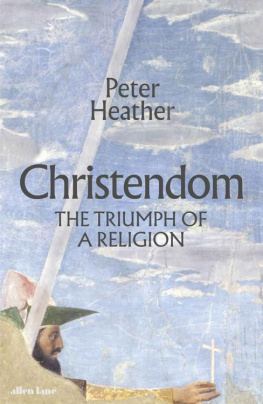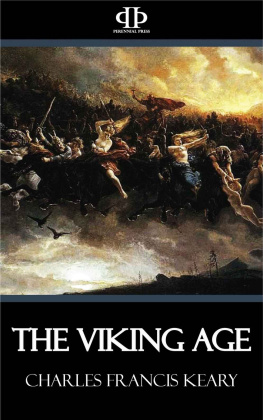C. F. Keary - The Vikings in Western Christendom, A D. 789 to A D. 888
Here you can read online C. F. Keary - The Vikings in Western Christendom, A D. 789 to A D. 888 full text of the book (entire story) in english for free. Download pdf and epub, get meaning, cover and reviews about this ebook. year: 2017, publisher: Forgotten Books, genre: History. Description of the work, (preface) as well as reviews are available. Best literature library LitArk.com created for fans of good reading and offers a wide selection of genres:
Romance novel
Science fiction
Adventure
Detective
Science
History
Home and family
Prose
Art
Politics
Computer
Non-fiction
Religion
Business
Children
Humor
Choose a favorite category and find really read worthwhile books. Enjoy immersion in the world of imagination, feel the emotions of the characters or learn something new for yourself, make an fascinating discovery.

The Vikings in Western Christendom, A D. 789 to A D. 888: summary, description and annotation
We offer to read an annotation, description, summary or preface (depends on what the author of the book "The Vikings in Western Christendom, A D. 789 to A D. 888" wrote himself). If you haven't found the necessary information about the book — write in the comments, we will try to find it.
C. F. Keary: author's other books
Who wrote The Vikings in Western Christendom, A D. 789 to A D. 888? Find out the surname, the name of the author of the book and a list of all author's works by series.
The Vikings in Western Christendom, A D. 789 to A D. 888 — read online for free the complete book (whole text) full work
Below is the text of the book, divided by pages. System saving the place of the last page read, allows you to conveniently read the book "The Vikings in Western Christendom, A D. 789 to A D. 888" online for free, without having to search again every time where you left off. Put a bookmark, and you can go to the page where you finished reading at any time.
Font size:
Interval:
Bookmark:
The Vikings in Western Christendom: A.D. 789-888
C. F. Keary
Copyright C.F. Keary 1891
The right of C.F. Keary to be identified as the author of this work has been asserted by him in accordance with the Copyright, Designs and Patents Act, 1988.
First published in the United Kingdom in 1891 by T. Fisher Unwin.
This edition published in 2015 by Endeavour Press Ltd.
Non ha lottimo artista alcun concetto,
Chun marmo solo in se non circonscriva,
Col suo soverchio.
Michelangelo
Table of Contents
Preface
The present volume is concerned with that period in the history of the Scandinavian peoples when they were growing, but had not yet fully grown, into nationalities, and when, therefore, their true national history had not begun. Every historic people has passed through this early formative period, its age of Sturm und Drang ; and it may be said that every nationality which is worthy of the name has looked back upon that age with a peculiar affection and with a sort of reverence. It has, in consequence, overlaid the faint traditions of it with a garment of mythology, out of which it is in most cases possible only here and there to separate a shred of historical truth. The result is that the very phase in the development of the people about which we most long to know, is the one about which we are condemned to the completest ignorance. The Viking Age of the Northern Folk differs from the corresponding epochs in the history of other nations in this that it is illuminated by a faint ray of real history lent from the pages of contemporary but alien chroniclers, the chroniclers, I mean, of Christian Europe. Were it not for this faint gleam, the earliest age of the Vikings would have remained for us as a mere tradition, something known to have been, but not presentable in any realizable form; much, in fact, what the Dorian Migration is in the history of Greece. As it is, by the aid of the contemporary records I have spoken of, we can present the northern migration in a clearer guise.
For all that, a distinction must be drawn between the earliest and, as I would call it, true Viking Age, and the actual history of the Scandinavian Folk as recorded by themselves. Viking expeditions continued to be made during the later historical period. But they took a different character from those of the earlier age, and they no longer absorbed so large a part of the activity of the people; at any rate they no longer constituted, as they do for our period, the only phase of national activity whereof the records remain. Thus, though the expression Viking Age is often employed with a much wider significance, it would, I think, be an advantage, could its use be confined to just this epoch in the life of the Northern people and to no other; to their age of Storm and Stress, the age of their formation.
It would be an advantage, too, if it were more generally borne in mind that the history of the North begins now and at no earlier time. The Vikings of this period are for us the whole Scandinavian people; we know no other if, at any rate, we except a notice here and there of the kings of Southern Denmark. But the pre-eminence of the antiquaries of the North, overshadowing the study of Scandinavian history, has rather tended to obscure this fact. All histories (almost) of Scandinavian lands begin with prehistoric antiquities, which are not history. Or it may be that the historians of these countries have not liked to realize how far down in time their history begins; so that prehistoric discoveries or unauthenticated traditions preserved in the sagas of a later age have been brought in to fill up what is for History in the proper sense of the word a mere blank.
Such, then, is the interest attaching to the age of the Vikings from the point of view of Scandinavian history. But its records are so shadowy that it would not be possible to claim for it a very large amount of attention upon that score alone. For universal history or say for the history of Europe generally it has a much deeper interest, as one phase, and a very important one, of the long struggle between Christianity and the Heathenism of the North. And it is under this aspect that the history is treated in the present volume. Otherwise there would be no adequate excuse for the three chapters with which the volume opens, nor for the one with which it concludes. These four chapters are not, strictly speaking, concerned with the Vikings; but they are concerned very intimately with the relations of Heathenism that is to say Teutonic Heathenism to Christianity and to Christian Europe. It has always been the intention, or at any rate the hope, of the present writer to carry on the study of this epoch one stage further; namely, to the formation and to the early history of the Scandinavian conquests and colonies in France, in the British Isles, in the islands of the North Atlantic; and, as a pendant to this external history, to the rise of the Edda and Saga literature and of the mythology which they enshrine the last articulate voice of Teutonic Heathenism. If such an enlarged study were ever completed, then the three opening chapters of this volume would serve as an introduction to the whole, and the concluding chapter as a link between this volume and the next. The half-title, too, Heathendom and Christendom would stand not for this volume only, but for any one or more succeeding one likewise.
I may, perhaps, be allowed to add that, to the best of my recollection, this book was begun in the earlier part of 1882; that its undertaking was due, more than anything else, to the publication of the first two volumes of Professor Steenstrups important work, Normannerne, to which I am glad to confess my many obligations; and that a volume (not identical with the present one) was ready for publication in 1887. But as, precisely at that moment, there appeared the announcement of a work by Mr. Du Chaillu upon a similar subject, publication was deferred until I could discover how far the book thus announced covered the ground over which I had travelled. The title which Mr. Du Chaillu chose for his book is the one which I had till then fixed upon for mine. But except in this one particular I was glad to find that the subject matter of the two books lay wholly apart.
C. F. K.
200 Cromwell Road,
London
November, 1890
Chapter One Heathendom
There are few physical features in our Europe today more impressive than the remains of those Roman roads which once traversed every land owning the Roman sway, and which have withstood so wonderfully the wear of time. In every western country of Europe traces of these roads are to be found still recognizable, though in most they have been absorbed into a more modern system. Such has been the case with us as in France. But still the ancient highways can be well made out our Watling Street, Fosse Way, Icknield Street, Ermine Street. In many parts of Spain these Roman roads remain untouched, but grass-grown and half-ruined, while beside them run the mule-paths, which are all that the indolent country now cares to keep in repair and use. Each one of these roads is a natural symbol of the state which brought it into existence, in its directness of purpose, its unswerving determination and contempt of obstacles, and likewise in a certain prosaic plainness. Yet we cannot call these roads prosaic in the sum, so inimitable are they in their vast, undaunted length, and even in the uniformity of their plan. Standing upon them you realize better than in any other way the long arm of Roman justice. If you put your ear to them, and the cloud-gates of Time will roll aside for a moment for you, you may still hear along all their length the tramp of legionaries, the challenges of the guard, the hurrying feet of merchants or of slaves; and you will reflect, with pleasure or the reverse of it according to your bent, how these were once the iron girdles which bound together all the members of a mighty empire in an unchanging rule of justice and of law.
Next pageFont size:
Interval:
Bookmark:
Similar books «The Vikings in Western Christendom, A D. 789 to A D. 888»
Look at similar books to The Vikings in Western Christendom, A D. 789 to A D. 888. We have selected literature similar in name and meaning in the hope of providing readers with more options to find new, interesting, not yet read works.
Discussion, reviews of the book The Vikings in Western Christendom, A D. 789 to A D. 888 and just readers' own opinions. Leave your comments, write what you think about the work, its meaning or the main characters. Specify what exactly you liked and what you didn't like, and why you think so.







